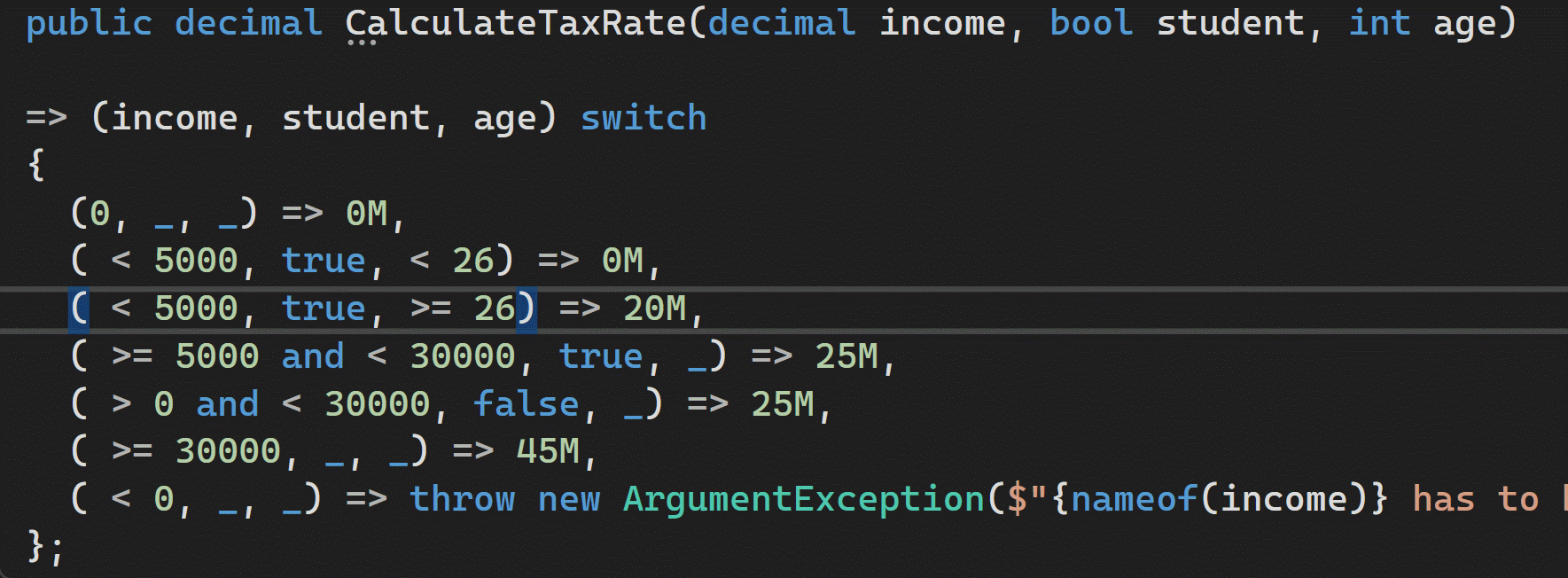
Complex business logic can be simplified by implementing
this as a decision table using C# pattern matching.
What are Decision Tables?
Decision tables are an excellent tool to model complex business logic,
and give you a straightforward way to detect missing combinations which should also
be considered.
Below I have a simple decision table to calculate taxes based on age and income.
This example is fictitious!
- When your income is 0, you pay 0% taxes.
- As a student you are allowed earn up to 5000 without paying taxes, on the condition you are less than 26 years old.
- Otherwise, older students pay 20% taxes up to 5000.
- Students who make more than 5000 pay 25%.
- All other people pay 25% if their income does not exceed 30000.
- When you earn more than 30000 you pay 45% taxes, even students.
- Negative incomes are not possible.
+-----------------------------------------------+
| income | student | age | tax rate |
+-----------------------------------------------+
| 0 | | | 0 |
+-----------------------------------------------+
| < 5000 | true | < 26 | 0 |
+-----------------------------------------------+
| < 5000 | true | >= 26 | 20 |
+-----------------------------------------------+
| >= 5000 | true | | 25 |
| < 30000 | | | |
+-----------------------------------------------+
| > 0 | false | | 25 |
| < 30000 | | | |
+-----------------------------------------------+
| >= 30000 | | | 45 |
+-----------------------------------------------+
| < 0 | | | 45 |
+-----------------------------------------------+
Using C# Pattern Matching to Implement Decision Tables
C# has support for pattern matching which allows you to take a bunch of values
and use combinations of these in logical expressions which are clearer and shorter
then the equivalent if statements.
I have implemented the above decision table in the CalculateTaxRate method below.
public decimal CalculateTaxRate(decimal income, bool student, int age)
=> (income, student, age) switch
{
(0 , _ , _ ) => 0M,
( < 5000 , true , < 26 ) => 0M,
( < 5000 , true , >= 26) => 20M,
( >= 5000 and < 30000, true , _ ) => 25M,
( > 0 and < 30000 , false, _ ) => 25M,
( >= 30000 , _ , _ ) => 45M,
( < 0 , _ , _ ) => throw new ArgumentException($"{nameof(income)} has to be at least 0")
};
This code matches the decision table in a perfect way!
Using a switch expression we can implement each row of the decision table.
- Empty cells in the decision table are implemented using a discard expression
_.
- Constant patterns such as
0 and true are used to check for equality.
- Relational patterns such as
< 5000 are used to compare values.
- Logical patterns such as
and, or and not can be used to combine expressions.
C# will even help you discover missing combinations:
The compiler will issue a warning when you comment out one of the possibilities:

If you like to learn more, visit pattern matching